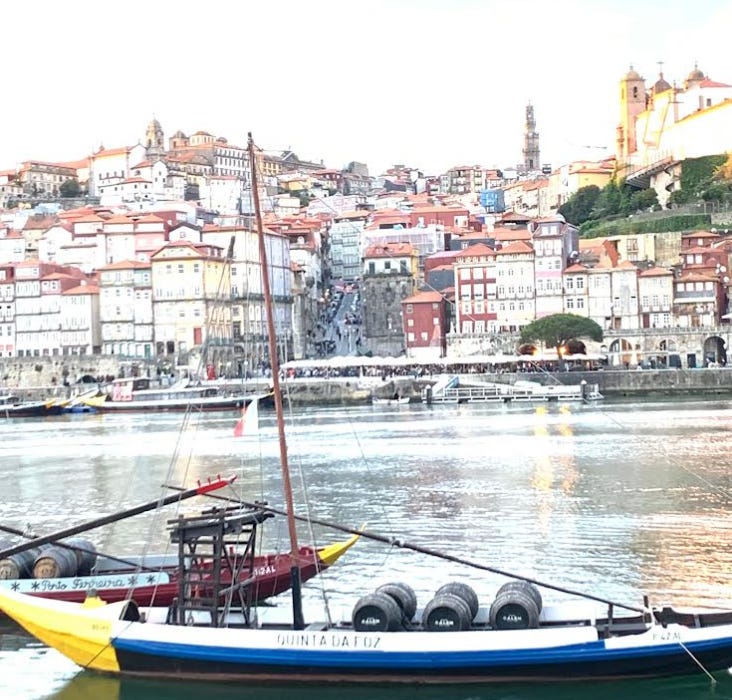The Magical City of Porto (Oporto) Portugal
History and Travel Notes from Chapters 14-18
These next few posts will be slightly different as I will mix the historical research with my personal experiences in Portugal. Any travel tips I provide are just to help folks. I get no referral fees.
The picture above was taken by Francis Frith and Co. sometime in the 1860s-1870s. The port city would have looked like this for Louisa and the Clan of the Dissipated when they arrived by ship.
See the red circle in the picture? That’s the small penthouse apartment that my wife and I stayed in during the Porto portion of our April 2022 tour of Portugal. Below is a picture I took of the same scene 150 years after the first.
Here is a view from that balcony going in the other direction. If you want to book that apartment, here is the link: PortoSense Ribeira. It is the perfect spot for two to experience the city’s unique history.
During our stay, Ranger Football Club fans from Scotland took over the square and sang their drunken songs for two days and nights. If anything, it added even more charm to the view.
As you can see, not much has changed in a city I would describe as well-worn, hard-working, and full of hidden gems. In Louisa Sophia and a Legion of Sisters, most of the Porto scenes in the book take place inside Bolsa Palace. Don’t let the outside of the building fool you; this is a must-visit on any Porto itinerary.
In chapter 15, Louisa and her friends attend a dance in the palace’s grand ballroom. During that ball, Louisa experiences the most traumatizing event of her life while visiting the most fantastic room this author has ever stepped foot in, and later she meets Gustave Eiffel.
Unfortunately, the day we visited the palace, the ballroom was serving as an exhibit hall, so many of my descriptions of the room in the book came from online pictures.
But the real jewel in any visit to Bolsa Palace is the Arab Room. In 1874, the room would be only partially finished. I describe it as if the back half of the room were complete while the rest was partially done or unfinished.
See the backlit door on the left? My research discovered most of those doors lead to closet-like rooms with lights or, in the case of the book, lamps. Louisa was fooled into thinking that each door led out of the room. She tried in vain to escape out one set of those doors.
This second photo shows the detail of one of the columns, and you can see the intricate design on the wall behind it. It is absolutely stunning. That it took a decade to complete the room is understandable.
Gustave Eiffel, yes, the architect who designed the tower in Paris, has a cameo appearance in chapters 17 and 18. During our guided tour of the palace, they showed us his office on the 2nd floor. This is a detail that I doubt I would have found without visiting the location in person.
Mr. Eiffel worked there while designing the Maria Pia Bridge across the Douro River. If you are an Eiffel aficionado, you might tell me that he did not office in Porto until 1876, and you would be correct. I fudged his appearance in the book by two years. I just couldn’t pass up the chance to add him to the story.
In Chapter 17 - Waltz of the Djinn, Gustave plays a small but pivotal role in the aftermath of what was for both the story’s heroine and the author who wrote the chapter a traumatic event.
It was the most emotionally difficult chapter I have ever written. I hope it does not bring up old wounds for anyone reading it but inspires women to act like Louisa. To resist and, when necessary, fight back against sexual assault predators like the book’s villain, João Lopes Gomes.
Last, I will leave with my very favorite Porto travel tip.
That’s a different João, the host of CHAMA, and me after too much wine and bagaceira, the Portuguese version of grappa. CHAMA is the best restaurant in Porto and possibly my favorite restaurant in the world.
Despite enjoying the fruits of my obsession, my wife doesn’t always appreciate that I’m a foodie. But I’m not one of those Michelin star food snobs. No, everywhere I go, I am looking for the trifecta.
1. Great-tasting food made with quality ingredients.
2. An incredible experience.
3. And finally, an affordable price.
CHAMA serves farm-to-table tapas, based on a set menu that changes every night. They only have about 20 seats, and tables are set close together. With João as emcee, we befriended the couples nearest us while enjoying 8-10 small courses over the three-hour meal.
Have I loved the food more in other places? Yes, but not by much. Have I experienced a local culture to a greater extent somewhere else? Probably. But I have never walked out of a 5-star experience in food, friends, and atmosphere while only paying such a paltry sum.
It was so wonderful that I asked João to work us in for a second night during our stay, but don’t try to wing it. Book well in advance. Click the link to their website and email them your travel dates.
I wish I could clone CHAMA, but it really is one of a kind.








